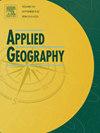城市边界制图的综合社会生态方法
IF 5.4
2区 地球科学
Q1 GEOGRAPHY
引用次数: 0
摘要
城市边界的清晰界定和准确圈定是城乡研究的前提。然而,城市边界通常是根据生物物理或社会经济特性绘制的,这给开展综合社会生态研究带来了障碍。在这里,我们开发了一种新的方法,将生物物理和社会经济的观点整合到城市边界测绘中,并在中国大陆进行了测试。首先,我们将研究区域划分为1 × 1 km的网格,并根据兴趣点(poi)和官方城乡分类将部分网格划分为城市和农村。然后将分类网格作为训练样本,确定不透水面百分比(ISP)的阈值,以进一步进行城乡分离。结合ISP(生物物理属性)与行政城市中心(社会经济属性)的连通性阈值,将未分类网格划分为城市或农村。最后,将所有城市网格合并,形成中国的城市边界(CUB)。与现有的城市边界产品相比,该方法将城镇制图和村庄制图的精度分别提高了15%和17%。该方法不仅能够提高地图绘制的精度,而且能够为城乡社会生态研究提供城市边界。本文章由计算机程序翻译,如有差异,请以英文原文为准。
An integrative social-ecological approach for urban boundary mapping
Clear definition and accurate delineation of urban boundaries are the prerequisite for urban-rural studies. However, urban boundaries have been typically mapped based either on biophysical or socio-economical properties, resulting in barriers in conducting integrative social-ecological studies. Here, we developed a new approach that integrates the biophysical and socio-economical perspectives for urban boundaries mapping, and tested the approach in mainland of China. First, we divided the study area into 1 × 1 km grids, some of which were classified into urban and rural based on Points of Interest (POIs) and official urban-rural classification. The classified grids were then served as training samples to determine thresholds of impervious surface percentage (ISP) for further urban-rural separation. Combined threshold of ISP (biophysical properties) with connectivity to administrative urban centers (socio-economical properties), the unclassified grids were assigned as either urban or rural. Finally, all urban grids were merged to create China's urban boundary (CUB). The integrative approach improved the accuracy of town mapping and village mapping by 15 % and 17 % respectively, compared with existing urban boundary products. Our approach is thus capable to improve mapping accuracy and provide urban boundary for social-ecological studies in urban-rural areas.
求助全文
通过发布文献求助,成功后即可免费获取论文全文。
去求助
来源期刊

Applied Geography
GEOGRAPHY-
CiteScore
8.00
自引率
2.00%
发文量
134
期刊介绍:
Applied Geography is a journal devoted to the publication of research which utilizes geographic approaches (human, physical, nature-society and GIScience) to resolve human problems that have a spatial dimension. These problems may be related to the assessment, management and allocation of the world physical and/or human resources. The underlying rationale of the journal is that only through a clear understanding of the relevant societal, physical, and coupled natural-humans systems can we resolve such problems. Papers are invited on any theme involving the application of geographical theory and methodology in the resolution of human problems.
 求助内容:
求助内容: 应助结果提醒方式:
应助结果提醒方式:


